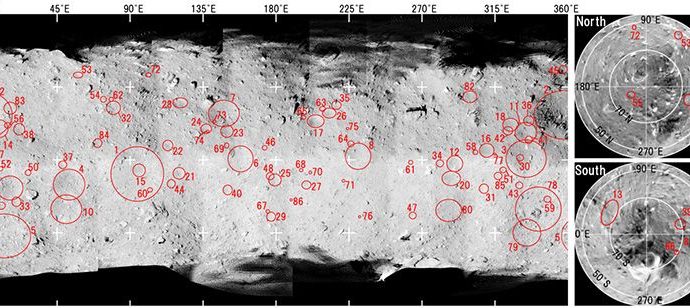The Japanese mission Hayabusa2 just bid farewell to the asteroid the probe spent a year and a half studying, and scientists have now announced some intriguing trends they noticed in the spacecraft’s photos.
Source: Space.com
Those trends had to do with the craters dotting the surface of the asteroid, dubbed Ryugu. The team used 340 different images of the space rock’s surface and identified a total of 77 craters scattered over Ryugu, each measuring at least 66 feet (20 meters) across. But those pockmarks aren’t distributed as evenly across the surface as the scientists might have expected, the researchers explained in a new paper.
Instead, the craters are clustered in a couple of different ways. There are more craters near the equator than the poles, the scientists found, and there are more on the eastern side of Ryugu than on the western. Additionally, the scientists didn’t find as many relatively smaller craters within this size range as they might have expected given the number of very large craters the space rock sports.
Those patterns became particularly clear when the team looked at particularly large craters, the 11 that measure at least 328 feet (100 m) across. (That collection includes Ryugu’s largest crater, Urashima, which is about one-third of the asteroid’s diameter.)
Of those 11 monster craters, five line up along the ridge ringing the asteroid’s equator. That’s more than twice as many as the team would have expected if Ryugu’s craters were distributed randomly, the researchers said.
The discrepancies don’t mean that the solar system has been targeting this one unremarkable space rock, of course. Instead, the team said that the clustering of craters is a result of the asteroid’s geological history.
The researchers said that most of the equatorial ridge is relatively old but the westernmost part is younger. That would explain why the craters are unevenly distributed: The rest of the ridge has had much more time to pick up these impact scars.
The scientists hope that when they analyze the samples from Ryugu now on their way back to Earth, it could better inform these theories about how the asteroid came to be the way it is now, a university statement about the project said. Those samples are due to land near the end of next year.
The research is described in a paper being published next spring in the journal Icarus.
Source: Space.com

































Leave a Comment
You must be logged in to post a comment.